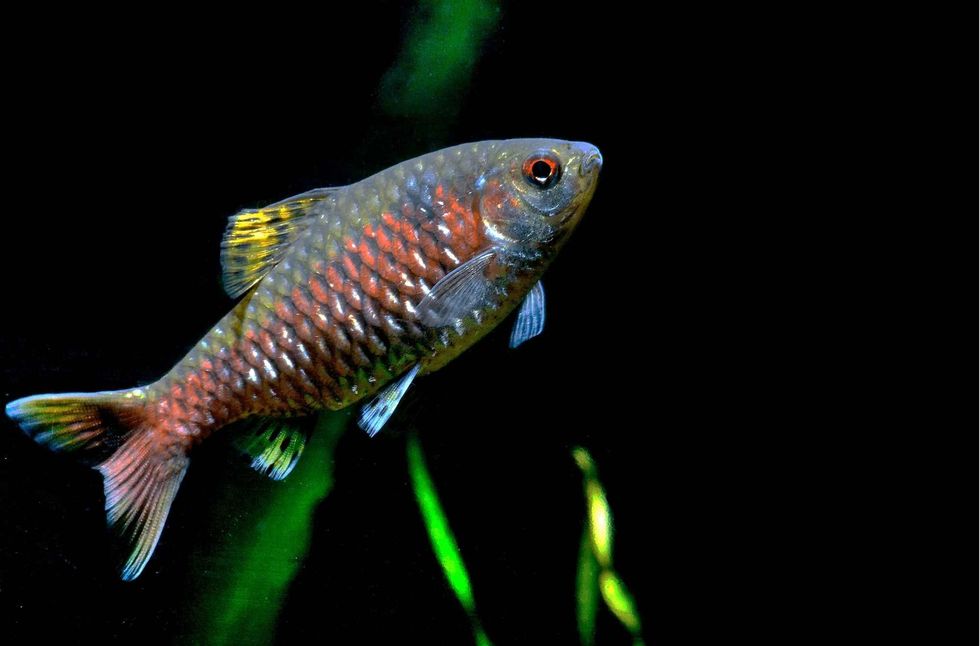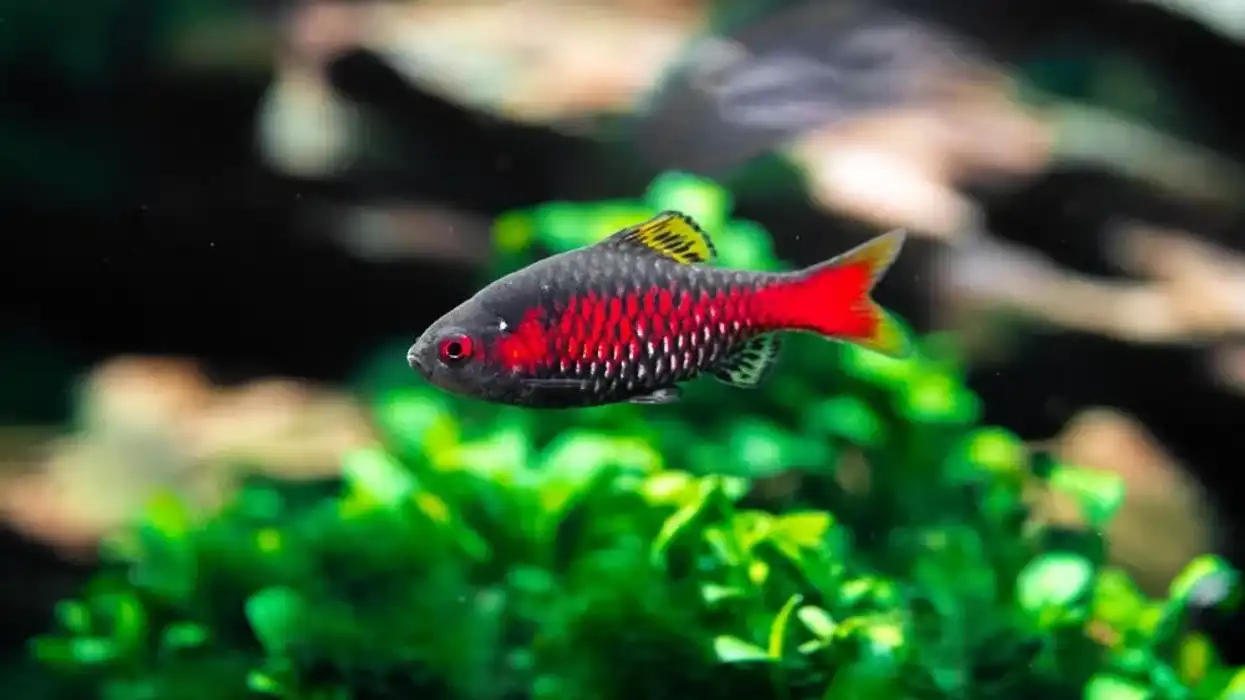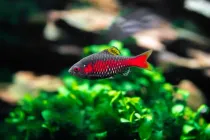Fun Odessa Barb Facts For Kids

The genus Barbus has a large variety of fish under it. Many of them have widely varying features from the original barbs and are unrelated to the genus.
However since they show beautiful colored scales and are well suited to aquariums or tanks, they are known to be barbs.
Odessa barb (Puntius padamya or Pethia padamya) is one such fish and it is also called the scarlet barb. Odessa barbs were believed to have appeared for the first time in a conference between pet fish enthusiasts in Odessa, Ukraine.
Although the fish can survive in a wide range of water conditions, imitating their natural habitat in their aquarium keeps them healthy and active. Odessa barbs are low-maintenance fish so caring for them is not at all difficult.
The aquarium or tank water should maintain consistency as drastic changes can lead to severe health problems in freshwater fish.
Caring for these beautiful fish is quite easy as they are low maintenance and they make a good choice for aquarists. Get to know about the species by going through these interesting facts about Odessa barbs.
For relatable content check out the neon tetra and the teira batfish.
Odessa Barb Interesting Facts
What type of animal is an Odessa barb?
Odessa barb is an unpopular and lesser-known freshwater aquarium fish species. The name of this fish is based on the place of its origin and sometimes they are commonly referred to as scarlet barbs.
What class of animal does an Odessa barb belong to?
The Odessa barbs are ray-finned and bony fish of the order Cypriniformes that belong to the class Actinopterygii.
How many Odessa barbs are there in the world?
Odessa barbs have become well known only recently so very little is known about them. As these fish are bred and kept in captivity all over the world their population is very hard to determine.
Where does an Odessa barb live?
The range of the distribution of Odessa barb's natural habitat includes various parts of Southeast Asia.
The fish is said to have originated in the freshwater streams of the central part of Myanmar.
They are found in the artificial pond situated above the Anisakan Falls in the village called Toe Gyi, the upper Mekong, the lower basin of the Chindwin River, which is a tributary of the Ayeyarwady, the upper Chao Phraya basin, Salween River, and in a small pond situated at a distance of 1640 ft (500 m) from the Ayeyarwady river.
These species are found covering an extensive area and wide varieties of habitats stretching from the Himalayas in the north to Thailand in the south.
The other Southeast Asian countries in which the Odessa barbs are found are China, India, Bangladesh, Bhutan, Sri Lanka, Pakistan, and Laos. These fish are also found in an aquarium or community tank as pet fish.
Unlike other barb species, the Odessa barbs have not yet become that popular so they are hard to find in ordinary pet shops.
What is an Odessa barb's habitat?
Odessa barbs live in clear aquatic ponds, rivers, or lakes.
They are found in the tropical freshwater streams of Southeast Asia and some occur at high altitude regions of 9843 ft (500 m). These fish mostly reside at shallow water depths and the water in their habitat is notably still and clear with very few aquatic plants or floating vegetation.
The fish is a bottom-dwelling one, swimming over the layer of substrate in search of plants and animals as their food.
Substrates found in their original place of occurrence are either muddy or made up of gravel. They live in areas where the water has a moderate pH level making it slightly acidic and a moderate current.
However, since the Odessa barb is a hardy fish they can manage slight variations in their water parameters.
Similar to their natural region's water, some customized water and tank conditions should be maintained in an aquarium or a community tank to pet these fish. They are found in moderate to cold water places in the wild as a result of which in captivity, the water temperature of the aquarium must lie between 57.2-71.6 F (14-22 C).
The tank should contain a moderate amount of aquatic plants with enough swimming space for the fish.
Who do Odessa Barbs live with?
Odessa barbs are social fish that can reside peacefully with their tank mates. In the wild, they are found in large homogeneous groups containing fish only of their type.
However, in an aquarium, if they are not kept in a group of at least five Odessa barbs, they might turn a bit aggressive toward their other tank mates. Their most compatible tank mates include different species of tetras, corydoras catfish, or other barbs. Their tank mates should be equal in size or smaller to them.
How long does an Odessa barb live?
Odessa barbs have a very short lifespan and can only live up to five years in the wild. However, under good care and a healthy environment, a captive fish can exceed its lifespan by one year or more, but that is very rare.
How do they reproduce?
Reproduction in these fish is not very difficult. In captivity, it is better to use a separate, heavily planted breeding tank for these freshwater fish.
The females who are ready to spawn look should be transferred to the breeding tank along with multiple males at night. They are transferred in small groups of males and females since determining pairs in them is difficult.
The number of males should be twice that of females. The females choose their mating pairs quickly and move to a more private place covered with plants with the male Odessa barb.
Spawning takes place the following morning and lasts for around four or five hours. The females have a litter size varying between 150-200 eggs. The female scatters the eggs throughout the aquarium and lays them in batches of 20.
The males follow the females and fertilize the laid eggs. The responsibility of the males and the females ends with fertilizing all the batches of eggs.
The parents should be moved immediately after the fertilization process ends as Odessa barbs are infamous for eating their eggs. The eggs fall on plant blades which prevent them from cracking.
The baby fish starts to swim after one day. During this stage, the fry can easily feed on small and new brine shrimp, and as they grow old larger shrimps are added to their diet.
What is their conservation status?
They are relatively less popular than the other relative barbs. As a result, the IUCN Red List could not enlist them under any specific status of their conservation. Very little is known about the pattern of their population.
Odessa Barb Fun Facts
What do Odessa barbs look like?

The Odessa barbs (Pethia padamya) are a strikingly beautiful species of freshwater fish that flaunts a simple, colorful body. The male Odessa has a brighter body as a result the male looks more stunning and attracts more aquarists.
They have an oval-shaped body that is elongated and depressed at both ends. The males have slimmer bodies while the females are a bit rounder with more meat towards their belly.
The body color of the fish varies from light brown to beige. Along the side, a bright red stripe is seen.
This stripe runs throughout the length of the body starting from the eyes to the caudal fin. The males have red eyes with a black streak that runs through the middle of their eyes. The dorsal fin, pelvic fin, and anal fin in the males appear semi-transparent with a yellowish-green coloring.
At the base of the tail fin and the pectoral fins, two distinctive black spots are present. These black spots are more defined in males than females.
The female fish have a more defined silver abdomen than the males. A single black spot in females is present at the base of the dorsal fins but it is fainter than the male.
Along the length of the fins, incomplete black rays are present. From a distance, the body of the fish looks semi-translucent with a bright red center portion.
How cute are they?
The small tank fish species are very cute and adorable. Their unique, big, reddish eyes melt the hearts of all aquarists.
How do they communicate?
Like all fish, the Odessa barbs use scent, sound, electrical impulses, and vision to communicate. Communication in fish is helpful for navigation as well as during reproduction.
How big is an Odessa barb?
Odessa barbs are small freshwater fish and their length varies between 2-3 in (5-7.5 cm). There is not much difference between the male and the female Odessa barb size.
How fast can an Odessa barb swim?
Odessa barb fish is a fast and active swimmer. They enjoy swimming in fast-flowing waters in the wild and accordingly, the tank should be set up in such a way that they have enough space to swim.
How much does an Odessa barb weigh?
The exact weight of Odessa barbs is approximately 0.8 lb (0.4 kg) but due to their small body, they are assumed to be lightweight fishes.
What are the male and female names of the species?
The male and the female fish species do not have any particular names. Both of them are collectively called Odessa barbs.
What would you call a baby Odessa barb?
The baby of an Odessa barb is called a fry.
What do they eat?
Odessa barbs feed on both plant and animal matter and their diet is omnivorous. Their feeding habit is not too complex and as a result, their diet includes a wide variety of food.
The variety ranges from microscopic organisms to vegetative matter and even a meaty diet. In an aquarium, the fish can eat dry and frozen flake food, and feeding them nutrient-rich food like brine shrimp, daphnia, and bloodworms keeps the fish healthy. In the wild, they feed on insects, detritus, and invertebrates.
Are they eaten by humans?
They are good community fish that form a nice attraction in aquariums. Since there is not much information about these fish as of yet, it is hard to determine whether they have been eaten by humans or not.
Would they make a good pet?
They are famous pet fish that originated in Southeast Asia. They can adjust to a wide range of conditions however they turn semi-aggressive if not kept in a school of their type. These barbs also have a habit of nipping the fins of slow long-finned fish.
Did you know...
The beauty of Odessa barbs can be observed best in darkness with dimmed aquarium lights.
How many Odessa barbs should be kept together?
Odessa barbs are schooling fish and should be kept in a group of at least five fish of their kind in an aquarium. They are small fish, and for five fish a minimum tank size of 30 gallons is necessary. It is better to keep them in a two-to-one ratio of male to female fish.
How can I get my Odessa barb to get more color?
At the time of birth, the Odessa barb's babies are paler in color. They gradually become more colorful as they grow.
The males show more colors while the female colors are a bit subdued. However, the intensity of the coloration of these barbs depends on their lifestyle. The health of the fish is reflected by its color and the more healthy they are, the more colors they have.
Here at Kidadl, we have carefully created lots of interesting family-friendly animal facts for everyone to discover! Learn more about some other fish including haddock and turbots.
You can even occupy yourself at home by drawing one of our Odessa barb coloring pages.
We Want Your Photos!
More for You
See All
Bachelor of Arts specializing in Journalism and Mass Communication, Postgraduate Diploma in Sports Management

Moumita DuttaBachelor of Arts specializing in Journalism and Mass Communication, Postgraduate Diploma in Sports Management
A content writer and editor with a passion for sports, Moumita has honed her skills in producing compelling match reports and stories about sporting heroes. She holds a degree in Journalism and Mass Communication from the Indian Institute of Social Welfare and Business Management, Calcutta University, alongside a postgraduate diploma in Sports Management.
Bachelor of Business Management specializing in Financial Management

Sapna SinhaBachelor of Business Management specializing in Financial Management
Sapna has a Bachelor's degree in Business Administration from Poornima University, Rajasthan. She has writing experience from working for a news agency as a writer, interning at various companies, and writing and editing articles on education.
Disclaimer
1) Kidadl is independent and to make our service free to you the reader we are supported by advertising. We hope you love our recommendations for products and services! What we suggest is selected independently by the Kidadl team. If you purchase using the Buy Now button we may earn a small commission. This does not influence our choices. Prices are correct and items are available at the time the article was published but we cannot guarantee that on the time of reading. Please note that Kidadl is a participant in the Amazon Services LLC Associates Program, an affiliate advertising program designed to provide a means for sites to earn advertising fees by advertising and linking to Amazon. We also link to other websites, but are not responsible for their content.
2) At Kidadl, we strive to recommend the very best activities and events. We will always aim to give you accurate information at the date of publication - however, information does change, so it’s important you do your own research, double-check and make the decision that is right for your family. We recognise that not all activities and ideas are appropriate for all children and families or in all circumstances. Our recommended activities are based on age but these are a guide. We recommend that these ideas are used as inspiration, that ideas are undertaken with appropriate adult supervision, and that each adult uses their own discretion and knowledge of their children to consider the safety and suitability. Kidadl cannot accept liability for the execution of these ideas, and parental supervision is advised at all times, as safety is paramount. Anyone using the information provided by Kidadl does so at their own risk and we can not accept liability if things go wrong.
3) Because we are an educational resource, we have quotes and facts about a range of historical and modern figures. We do not endorse the actions of or rhetoric of all the people included in these collections, but we think they are important for growing minds to learn about under the guidance of parents or guardians.







